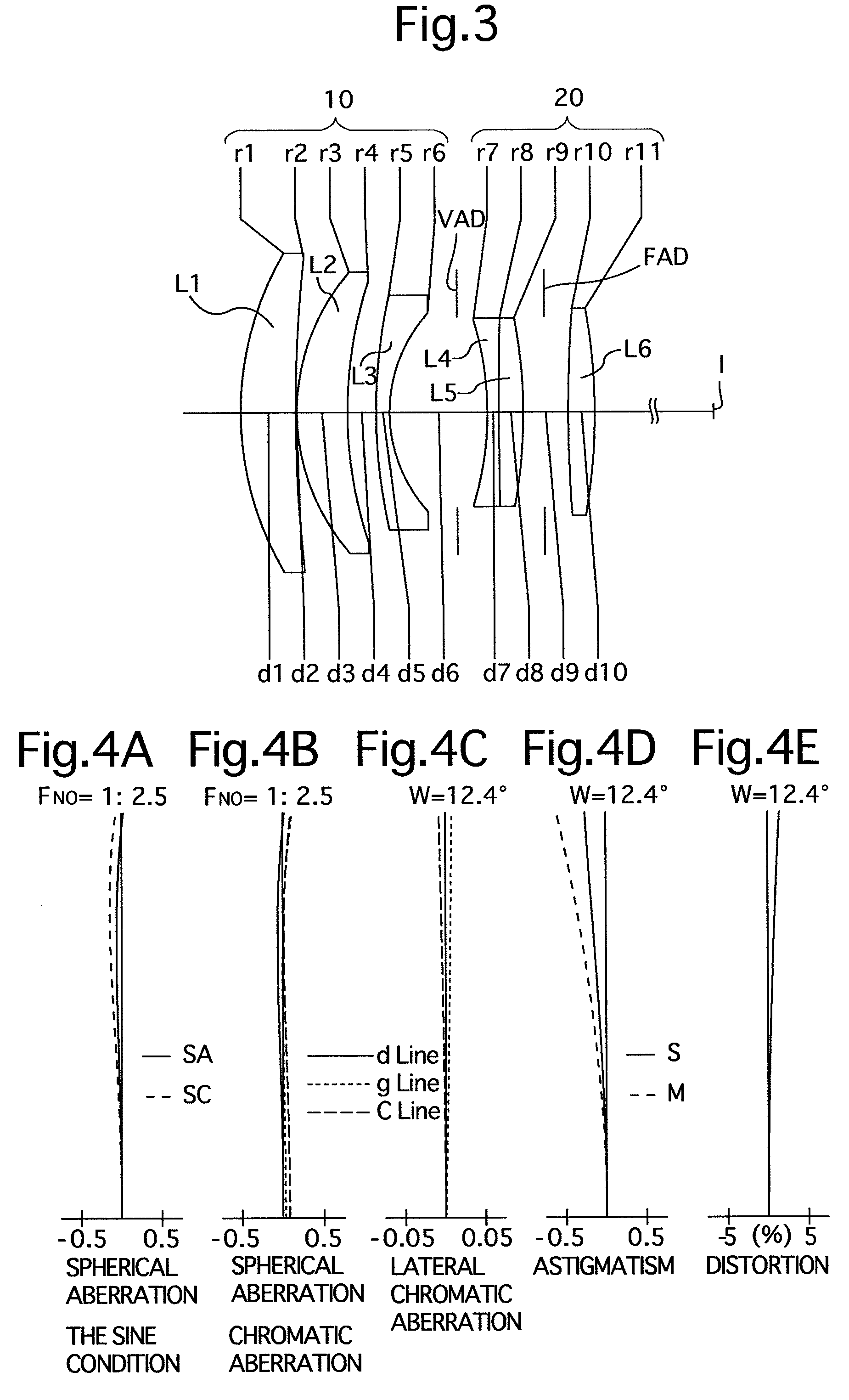Intermediate telephoto lens system
a telephoto lens and coma technology, applied in the field of telephoto lens systems, can solve the problems of gauss-type lens systems that are not suitable for forming telephoto lens systems, unable to have symmetry in the ernostar-type lens system, and not suitable for spherical aberration and coma correction, so as to facilitate the formation of telephoto-type lens systems, the effect of correcting astigmatism and distortion
- Summary
- Abstract
- Description
- Claims
- Application Information
AI Technical Summary
Benefits of technology
Problems solved by technology
Method used
Image
Examples
embodiment 1
[0086]FIG. 1 is the lens arrangement of the intermediate telephoto lens system, according to the first embodiment of the present invention. FIGS. 2A through 2E show aberrations occurred in the lens arrangement shown in FIG. 1.
[0087]Table 1 shows the numerical data of the first embodiment.
[0088]The positive front lens group 10 includes two positive meniscus lens elements each having the convex surface facing toward the object (the positive first lens element L1 and the positive second lens element L2), and a negative meniscus lens element having the convex surface facing toward the object (the negative third lens element L3), in this order from the object.
[0089]The positive rear lens group 20 includes cemented lens elements having a negative meniscus lens element (the negative fourth lens element L4) having the convex surface facing toward the image and a positive meniscus lens element (the positive fifth lens element L5) having the convex surface facing toward the image, and a bicon...
embodiment 2
[0092]FIG. 3 is the lens arrangement of the intermediate telephoto lens system, according to the second embodiment of the present invention. FIGS. 4A through 4E show aberrations occurred in the lens arrangement shown in FIG. 3.
[0093]Table 2 shows the numerical data of the second embodiment.
[0094]Except that the negative fourth lens element L4 is constituted by a biconcave lens element, and that the positive fifth lens element L5 is constituted by a biconvex lens element, the basic lens arrangement of the second embodiment is the same as that of the first embodiment.
[0095]The variable-aperture diaphragm VAD is positioned 2.709 in front of (on the object side of) the positive rear lens group 20 (surface No. 7).
[0096]The fixed-aperture diaphragm FAD is positioned 1.0 in front of the positive sixth lens element L6 (surface No. 10).
TABLE 2FNO. = 1:2.5f = 68.61W = 12.4fB = 37.82Surf. No.rdNdν127.5924.791.6980055.42128.8000.10318.8644.351.7000052.8437.5752.43547.5681.151.8050027.4612.9538....
embodiment 3
[0097]FIG. 5 is the lens arrangement of the intermediate telephoto lens system, according to the third embodiment of the present invention. FIGS. 6A through 6E show aberrations occurred in the lens arrangement shown in FIG. 5.
[0098]Table 3 shows the numerical data of the third embodiment.
[0099]The basic lens arrangement of the third embodiment is the same as that of the first embodiment.
[0100]The variable-aperture diaphragm VAD is positioned 2.766 in front of (on the object side) of the positive rear lens group 20 (surface No. 7).
[0101]The fixed-aperture diaphragm FAD is positioned 1.0 in front of the positive sixth lens element L6 (surface No. 10).
TABLE 3FNO. = 1:2.5f = 67.98W = 12.6fB = 37.82Surf. No.rdNdν129.6564.421.6968055.52117.2890.10319.3884.051.6968055.5433.7513.98540.3981.161.7851725.7613.1449.097−24.9051.001.6984032.08−132.2291.781.5281457.89−42.8262.4810107.8272.631.7594028.911−45.857—
PUM
 Login to View More
Login to View More Abstract
Description
Claims
Application Information
 Login to View More
Login to View More - R&D
- Intellectual Property
- Life Sciences
- Materials
- Tech Scout
- Unparalleled Data Quality
- Higher Quality Content
- 60% Fewer Hallucinations
Browse by: Latest US Patents, China's latest patents, Technical Efficacy Thesaurus, Application Domain, Technology Topic, Popular Technical Reports.
© 2025 PatSnap. All rights reserved.Legal|Privacy policy|Modern Slavery Act Transparency Statement|Sitemap|About US| Contact US: help@patsnap.com



